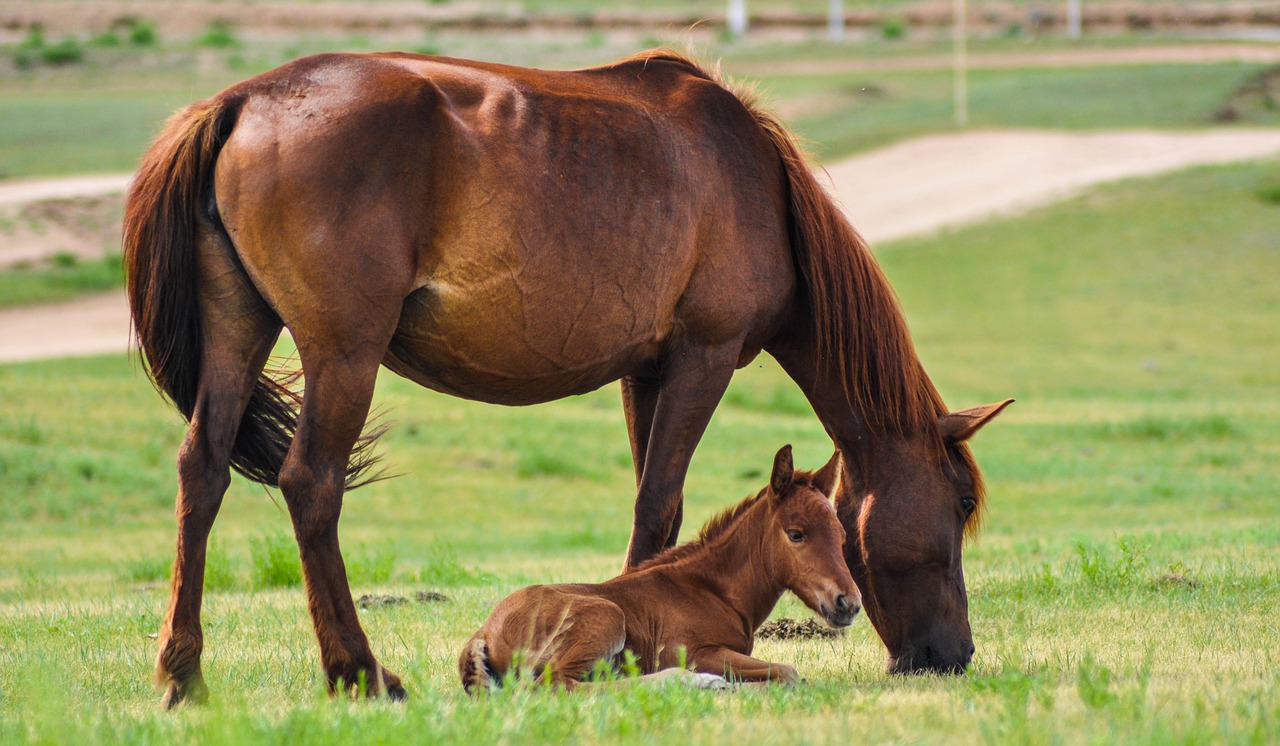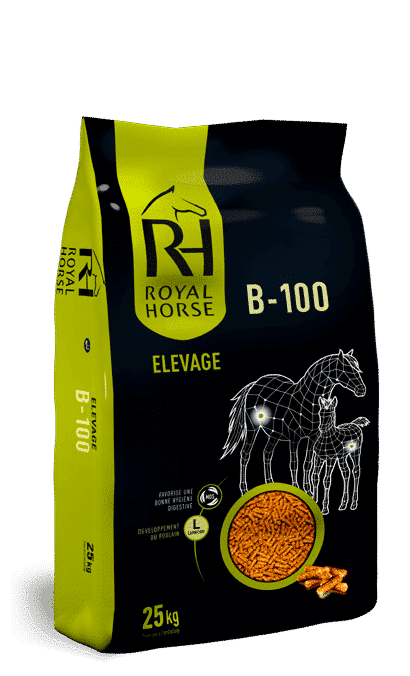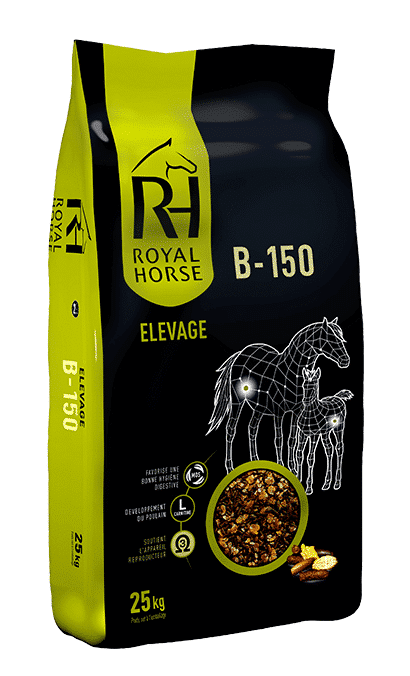Today’s foals are tomorrow’s athletes and if we want these athletes to perform at their best, it is important to provide them with all the nutrients they need to grow and develop to their full genetic potential and become the great athletes you want them to be. Foal nutrition begins in the mare’s womb during the months of gestation, so it is very important that the mare is fed properly.
Feeding the pregnant and lactating mare
Good horse development starts very early… you could even say it starts with the pregnant mare! It is essential to identify the mare’s nutritional needs in order to ensure an optimal gestation. The pregnant mare’s nutritional needs increase significantly at the end of gestation (especially the last 3 months), as it is during this period that the foal completes its development and begins to grow to the size and weight it will have at birth. For the above reasons, the mare must be fed a diet that meets her nutritional needs and also allows her to build up body reserves that will help her produce a good quantity of milk after foaling and to be quickly rebred.
If the mare receives an adequate feeding program during gestation and lactation, very important benefits can be obtained, such as the fact that the brood mare can return to heat quickly after foaling and thus have another foal the following year. In addition, the milk production will be adapted and the foal will be able to be fed optimally during the first months, since during this period, the milk of the lactating mare will be the only source of food for the foal. It is important for growing horses to receive all the nutrients they need from the mother’s milk to develop fully.
The diet of the pregnant and lactating mare is as important as that of the foal. It is necessary to avoid excess energy and vitamins, and to create an imbalance of other nutrients.
The importance of colostrum
Colostrum is the first food produced by the mare before foaling. It is yellowish in color, creamy in consistency, rich in energy, nutrients, antibodies for the immune system and has laxative properties. It is therefore very important that the foal, at birth and during its first 24 hours of life, ingests a sufficient quantity of colostrum in order to receive the nutrients and energy necessary to live. Colostrum is only produced before foaling and given to the foals during the first hours after birth. If the mare should die, or if she is not taking care of her foal, some breeders make up colostrum banks or colostrum can be found in the market. It will then be essential to feed the foal by hand on a regular basis, or to find an adoptive nursing mare.
As soon as she gives birth, the mare will start producing milk that will fully cover the foal’s needs for the first two months of its life. The foal can take between 60 and 70 feedings per day in its first months. After these two months, the milk production and nutritional quality of the milk starts to decrease, and about 3 months after the foal is born, the milk no longer provides all the nutrients it needs. It is therefore very important that the foal receives adequate nutrition to cover its developmental needs. The “breeding” food given to the mother during this period is often sufficient
FOAL FEEDING
The foal’s digestive system at birth is not adapted to digest fiber. Instead, the best source of nutrients for the foal is milk. Milk proteins are the ones that the foal digests and absorbs in the best way compared to forage proteins, as its digestive system is not yet ready to assimilate solid food perfectly, and the establishment of a flora responsible for the degradation of fibers will take place progressively over time. On the other hand, the following table presents the percentages of concentrates and forage that a foal must consume to obtain a good functioning of the digestive system, an optimal development and a regular growth.
| Age of the foal (months) | % of feed | % of fodder in the diet |
| 4 – 6 | 70 | 30 |
| 6 – 12 | 60 | 40 |
| 12 – 18 | 45 | 55 |
| 18 – 24 + | 50 | 50 |
*During the first 2 to 3 months, the foal only consumes mare’s milk. From 6 to 8 weeks of age, the foal’s weaning can begin gradually. The foal can start to consume the mother’s food by mimicry and in small quantities.
In some cases, foals start their training program between 18 and 24 months of age. The horses’ diet must then be adapted to their new life and the anticipation at the feeding level must call upon specific feeds with adapted feeding programs (do not hesitate to ask for our programs and specific feeds from our technical salesmen in the field). For example, Royal Horse B100 and B150 feeds are adapted to breeding horses and cover all the needs of pregnant and nursing mares, foals and stallions. For foals intended for racing careers, with early weaning, specific food programs can be set up, while for a sport or leisure horse which will be broken in around its 3 years old will not require specific breeding food after its 18 months.
It is also advisable to distribute fodder as much as possible to encourage continuous ingestion, or at least twice a day, 1/3 of the fodder ration in the morning and 2/3 in the evening.
SPECIFIC FEEDING OF THE FOAL, FOAL PARK
This feeding system, in which only the foal has access to the food, is a great help for the foal to develop optimally. This system prepares the foal to eat solid food at the time of weaning, so that it can continue to grow. It also prevents more aggressive foals from consuming more food than some of the more timid foals.
This feeding system consists of placing barriers to prevent the mares from accessing the foal’s food and in this way, they consume their own food. For what has been mentioned in the previous lines, it is important to remember that foals older than 4 months can begin to consume food that meets their needs since the mare’s milk at this age decreases in nutritional quality. For this reason, it is recommended to implement this feeding system between 6 and 8 weeks of age of the foals
Other advantages offered by the backdoor feeding system over traditional systems include:
- Encourages foal growth (resulting in larger and heavier foals than those who were not fed the creep).
- Decreased stress related to withdrawal.
- Less weight loss at weaning.
- Less problems with their new life (post-weaning) because they are already used to solid food.
It is very important to note that when using the backdoor feeding system for foals, they must be provided with a special foal feed that is formulated and balanced to meet their nutritional needs.
The key to good development is a balanced supply of energy, protein, vitamins and minerals, as well as a good preventive medicine program. The amount of concentrates must be adjusted, as deficiencies or excesses of energy or other nutrients can lead to stunted growth or potential metabolic problems such as orthopedic developmental diseases, etc.





